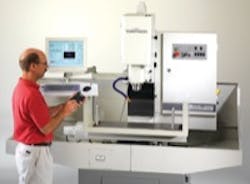Tomach's New 'Personal' CNC For Do-It-Yourself Production
KFx Medical is a venture-capital start-up with a new idea for orthopedic surgery: the repair of rotator cuffs, one of the most common procedures in the field. The company's new technique, called "SutureCross Knotless Anatomic Fixation," involves simpler and stronger fasteners to tissues, and does not require a surgeon to tie suture knots, a skill not possessed by all orthopedic professionals.
To get the ideas for the fixtures and the application instruments from the virtual realm of CAD to real testable prototypes, Ko and the KFx development team did the precision cutting themselves. The small company invested in the Tormach PCNC 1100, a new kind of lightweight mill designed to maximize power and capability for short runs, and to be simple enough for the nonmachinist to operate. By keeping the multiple iterations of prototype designs in-house, KFx Medical avoided the high costs and long delays involved with outsourcing dozens of parts for CNC machining.
"We would have had to spend at least three times as much money to get the quality and capability that we got from the Tormach," said Ko. KFx Medical was able to cut its own prototype and pre-production components out of plastic, aluminum and stainless steel. Even 420 stainless steel injection mold cavities were cut in house in a matter of days rather than the weeks that would typically be quoted by an outside shop, accomplished without the need to hire an experienced CNC programmer or machinist. "We were even able to use the 4th axis rotary capability of the Tormach to fabricate prototype 316SS bone screws with a variety of tapering spiral thread designs — all in house," added Ko.
In recent years, the price of CAD and 3D modeling software has brought the technology within reach of individual designers, entrepreneurs, and hobbyists. Last decade's innovation of rapid prototyping and 3D printers allowed for the easy fabrication of plastic replicas fabricated in the design studio — rather than the shop floor — to test the fit of parts and assemblies before production of actual prototypes begins. But the final step in the process from idea to product - creating a real physical prototype out of final materials required experienced machining.
"The software and hardware have become so capable, that one person can learn to use and actually afford all the tools necessary to go from the initial concept, to the virtual model, to the fabricated physical part without the need for a skilled CNC programmer or a skilled CNC operator," said Ko.
The term ‘Personal CNC' is used by Tormach LLC (www.tormach.com) to describe their new PCNC 1100 3axis vertical milling machine. The PCNC 1100 sells for about $6,800, which Tormach says is about onefifth the price of a traditional vertical machining center of comparable size (with a standard 34 in. by 9.5 in. table and 17 in. vertical clearance) and of comparable precision and capabilities (able to cut iron, steel, titanium and chromium alloys such as 300 or 400 series stainless). The mill weighs 1,130 lbs., is equipped with a 1.5 hp, 4,500 rpm variablespeed spindle, uses a modern bed mill style frame and iron construction, dovetail ways and ground ballscrews, and has a 15-point lubrication system with full-bellows covers. Available upgrades include fourth axis, 20,000 rpm spindle, integrated stand and a quick-change tooling system.
The PCNC 1100 is specifically intended for short run production, R&D prototyping, business startups, machining instruction and hobby applications.
